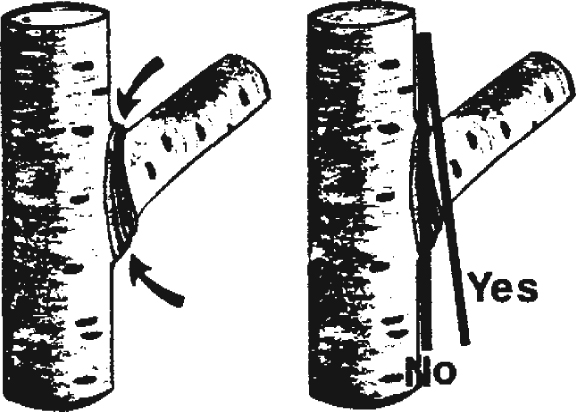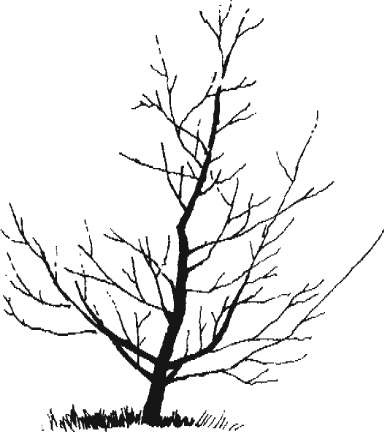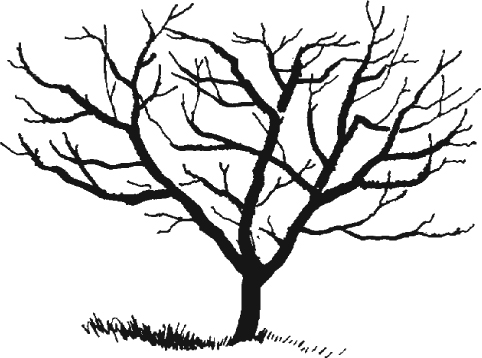Annual Pruning of Fruit Trees
- Jump To:
- Apple
- Peaches
- Other Tree Fruits
Pruning and training are two of the most important cultural practices for managing fruit trees and begins at planting. Pruning is simply the removal of parts of the tree. Training is directing the growth of the tree into the desired form through pruning, limb spreaders, clothespins or other means. There are many reasons for pruning fruit trees, probably the most obvious is to reduce tree size for its allotted space in the orchard. It is important to keep the aisles open for orchard equipment and easier harvesting. Pruning and training can be used to form a strong framework that will support a heavy fruit load. Broken, dead or diseased branches should always be removed, but probably the most important reason for pruning is thinning the branches so light penetrates throughout the tree.
The leaves of a fruit tree utilize light to manufacture the sugars used for growth, fruit production and maintenance. If water and nutrients are in good supply, the amount of sugar a leaf can produce is dependent on the amount of light it receives. The leaves on shaded interior branches do not produce enough sugars for normal functioning, and any fruit produced on these branches will be small, poorly colored and of low quality. Bloom and fruit set will be poor on shaded branches. The branches will weaken and eventually die. Red color development is also dependent on light, so increasing the light exposure of the fruit will increase color development. This is especially critical with red apple cultivars, since most do not color well with the warm conditions in Oklahoma. An added benefit of opening up the tree for better light penetration is that air circulation is improved, providing better drying conditions, which reduces disease pressure. There is also better spray penetration and coverage of the leaf surface.
An unpruned tree has a balance between the amount of root and the amount of top. Removal of parts of the tree by pruning will decrease the number of growing points in relation to the root mass, which will increase the vigor (length of the growth) of the remaining shoots as the tree attempts to balance the top and roots.
If pruning is too severe, extremely vigorous and unproductive wood is produced, which complicates next year’s pruning. It is better to remove some wood every year rather than pruning severely every three years to four years. It is also important to start training the tree from the very start, selecting branches to become the main scaffold limbs and removing the others before they become large. This will minimize the need to make large cuts later in the life of the tree.
In the first few years of the tree’s growth, emphasis should be on selection of scaffolds, training for good structure and promoting vegetative growth so the tree can fill in its allotted space in the orchard as soon as possible. Even though it increases the vigor of the remaining branches, pruning will decrease the size of the tree when compared to an unpruned tree. During the establishment years, pruning should be restricted to only those cuts necessary to develop the desired branch structure.
Fruiting and vegetative growth compete with each other for the sugars produced by the leaves. If the tree is allowed to fruit too soon, vegetative growth will slow and the tree will take longer to come into full production. For the first two years and possibly for the third, all flowers and fruit should be removed. On the other hand, if a bearing tree loses its crop because of a spring frost or winter cold, extra vigorous vegetative growth will result, making pruning more difficult next spring. If a crop loss occurs, the amount of nitrogen fertilizer applied should be reduced by half.
Close attention should be paid to the angle where the scaffold branches join the main
trunk (the crotch angle). Upright growing branches (with less than a 45-degree crotch
angle) usually have weak crotches, which can split when the branch is weighted down
with fruit or ice. A crotch angle of 45 degrees to 60 degrees is best to provide structural
strength, promote formation of fruit buds and to fill in the allotted tree space laterally.
A branch that does not have an adequate crotch angle can often be spread mechanically. This is usually only practical on those trees trained to a central leader, such as apple and pear. If scaffold selection is made at four inches to six inches of growth, the shoots can easily be spread to the proper angle with limb spreaders or spring‑type clothespins. The clothespins are clamped around the main stem just above the shoot to be spread, with the shoot coming up between the ‘handles’ of the clothespin. This is only effective during the spring of the first year, and will only affect the part of the branch right near the trunk. The clothespin need only be left on the tree a few months. As the branch gets older, sturdier spreaders will be needed. The length needed will depend on the size of the branch to be spread. They can be made of stiff metal rods sharpened at both ends, or lengths of wood with sharp metal spikes in the ends. One end of the spreader is braced against the main trunk and the other end holds the scaffold out in the desired position. A scaffold may need several spreaders of increasing length at different times in its development. Once a branch is three years old, it is difficult, if not impossible, to spread.
Always cut back a branch to another branch or the trunk. Never leave a stub. Cuts should not be made parallel to and flush with the trunk. At the base of a branch, there will be a ridge of bark called the collar. The cut should be made just above this collar; usually this will be at a slight angle (Figure 1). Leaving the collar undamaged promotes healing of the pruning wound. Tree wound dressings have not been found necessary.
The best time for pruning fruit trees is in January to early March. Later in the spring is better, especially with peaches. Pruning can slightly reduce winter hardiness of the trees. If trees are pruned in early winter, the coldest weather is still to come and may expose the trees to damage. It is better to prune during bloom than too early. Delaying pruning also allows the grower to assess winter damage to the flower buds, with the option to leave more buds when pruning. Almost all of the pruning in fruit trees can be done with a pair of lopping shears, a pruning saw for the large cuts and a pair of hand shears for fine cuts.

Figure 1.
Apple
The tree should be headed at 30 inches to 36 inches when planted. The top-most bud will take over as the leader and grow very vigorously straight up. The buds in a 4- to 6-inch zone below the top will also be quite vigorous and will usually have poor crotch angles. They should be stripped out when two inches to three inches long or spread immediately. Branches below this region will tend to have better crotch angles.
The best time to start establishing good light penetration in a tree is during its
first growing season. Scaffold limbs should be selected that have a 60-degree crotch
angle and are growing in an outward manner. Apples should have three to five scaffolds
in the bottom tier, well distributed on all sides of the tree and with the central
leader maintained. Scaffold selection should be made early and extra shoots removed.
A second tier of scaffolds is made starting 24 inches to 30 inches above the first tier. When using semi‑dwarf rootstocks such as MM 111, there should be a third tier the same distance above the second.
It is important that these scaffold limbs do not grow straight up. Vigorous upright growth tends to be less fruitful and it will interfere with the limbs above. If the scaffolds can be made to grow outward, the width of the tree will increase, which will increase the amount of light intercepted by the tree. Some cultivars are cooperative in producing wide-angled, spreading limbs. Red ‘Delicious’ frequently grows straight up. Effective management of ‘Delicious’ demands that mechanical spreading of the scaffold limbs be done to prevent crowding of the branches and shading of the interior and to promote lateral growth and fruitfulness.
Once the shape of the tree has been established and the tree is mature, the annual
pruning is a matter of removing upright growing shoots, competing shoots, dead wood
and shortening any branches growing too tall or wide. Most of the pruning cuts on
a mature apple tree will probably be in the top part to prevent shading out of the
lower branches. When an older tree is not trained properly when young, it creates
problems later in the life of the tree. There will be a mass of branches, some weak,
others large and probably most will have poor crotch angles that are too old and rigid
to spread. A picture-perfect tree may not be possible, but pruning will help to make
the most of the tree.
The general shape of the trees should be similar to an inverted cone: narrow at the top and gradually widening to the bottom (‘Christmas tree’ shaped, see Figure 2.) Remove any dead wood first for easier assessment. Take a careful look at the tree and decide which branches to leave for the lower tier and what to use as the central trunk. Younger branches may be spread, and older branches can be cut back to an outwardly growing side branch which, if possible, can be spread. Try to leave six inches to eight inches vertical distance between the chosen scaffolds. Start choosing for the second tier 24 inches to 30 inches above the first tier, following the same methods as the first tier. These branches will probably need shortening by cutting back to a side shoot. Add a third tier 24 inches to 30 inches above the second. Remember to maintain the inverted cone ‘Christmas tree’ shape.

Figure 2.
Do not make a lot of fine cuts on the branches left; save that for next year. A general rule is not to remove more than 1/3 of the wood at any dormant season pruning. The tree will respond to drastic pruning by sending out vigorous regrowth, so be prepared to deal with it. Vigorous upright growth on the trunk and along the branches will need to be removed either during the summer or at the next dormant season pruning. The best timing for summer pruning in Oklahoma has not been established, but based on work in other states, sometime during August is recommended.
Peaches
Peaches are normally trained to an open center or vase-like system. On a mature open-center tree, when standing next to the trunk, the sky should be visible when looking up. In this system, the tree has a relatively short vertical main trunk, with three to five main scaffolds arising from the trunk and distributed equally in all directions (Figure 3). For maximum strength, the scaffold branches should form a 60-degree angle with the main trunk when the tree has matured. Usually an initial scaffold angle of 30 degrees to 45 degrees is chosen. After one or two heavy crops, the scaffolds will spread out into proper position. Initial angles greater than 60 degrees will spread too far when the tree begins to bear fruit. No scaffold should come from lower than 12 inches aboveground to avoid interference with orchard equipment. The center of the tree is kept open by pruning, to allow light in from the top into the center of the tree. The height may vary according to the grower’s preference, but the trees may be kept to approximately eight feet tall with judicious pruning. Thus, no ladder is required to prune or harvest.

Figure 3.
Training to an open center starts at planting time. There are two general methods to obtain the desired branch structure. The first of these is to cut the young tree back to 18 inches to 24 inches in height and prune back any existing side branches to one bud to two buds. Completely remove any branches lower than 12 inches aboveground. Several branches will grow during that season, and the best-positioned and best-angled branches can be selected as the permanent scaffolds.
The second method starts the same way, but the young tree is cut at 30 inches to 36
inches in height. The top two to three branches tend to grow upright and not be the
best scaffolds. In the second method, these top branches are pinched back at 18 inches
and kept pinched back. This forms a ‘bushy center’ that forces the lower branches
to grow out and around the center, which results in better crotch angles on these
lower branches. The ‘bushy center’ is removed after the first growing season and the
permanent scaffolds are selected from the lower remaining branches.
Whichever method is used, it is helpful to completely remove all growth below the chosen scaffolds for the first two years. If this is done when the growth is still succulent, the shoots can be pulled off with minimal regrowth. This pruning may need to be done up to three times in the first year. This pruning concentrates growth in the desired scaffolds and can help reduce wind damage to the young trees.
In years two and three of growth, pruning is usually limited to broken branches, maintaining
the proper number of scaffolds and keeping the center of the tree open by removing
inward‑growing and upright branches. By year four and later, pruning cuts will be
required to keep the height of the tree down and to keep the tree from growing too
wide, in addition to cuts required to keep the center open. Some of the small and
medium‑sized branches will need to be removed to avoid competition with other branches
and let light into the tree canopy. Remove any drooping branches that will reach the
ground or interfere with orchard equipment. In almost all cases, the cuts made will
be thinning cuts, which is removing a branch all the way back to where it joins another
branch or the main trunk. Several moderate thinning cuts can do much to reduce the
height of a tree and open it up to light penetration.
Peaches fruit on last year’s growth. In the winter, the fruiting wood will be red and more vigorous. When pruning, try to keep the fruiting wood as low as possible to make it easier to thin and harvest the fruit, and keep it as close to the main trunk as possible to minimize limb breakage. Take advantage of years with no crop, due to spring freezes, to reduce the height and width of overgrown peach trees. By doing the necessary pruning in early spring, the tree will have a chance to regrow branches that are more conveniently placed before the next spring.
Other Tree Fruits
Pears are pruned like apples, but since they have a more upright growth habit, more attention will need to be given to limb spreading for early and maximum production. Cherries are also pruned similar to apples. Cherries have upright growth and will need attention to selecting and spreading limb angles. Cherry wood can be brittle, so care should be used to avoid breaking limbs with spreaders. Other stone fruits, such as plum and apricot, are pruned to an open center structure similar to peaches. There is nothing preventing an apple, pear or cherry tree as an open‑center tree or a peach tree with a central leader. For most tree fruits, the central leader training system has proven to be the most productive and strongest structured. Even if the training system can best be described as ‘free‑form,’ it will benefit from annual pruning to maintain vigor and improve light penetration and use.
Growing quality fruit requires work, and proper pruning is only one of the needed
components. Leaf and soil analysis, coupled with balanced fertilization, selection
of adapted varieties, weed control, fruit thinning, avoiding water stress, pest and
disease control and careful harvesting and handling at the proper picking time are
needed to come up with a quality product.
Becky Carroll
Sr. Agriculturist
Extension Fruit and Pecan
